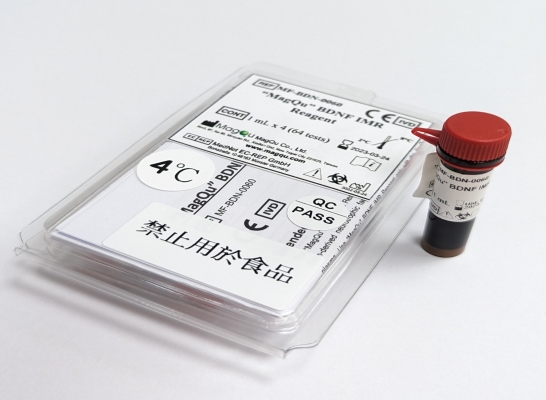Product

“MagQu” BDNF IMR Reagent
- Catalog No. MF-BDN-0060
- CE-IVD Certification
- For rapid quantifying brain-derived neurotrophic factor(BDNF) by ImmunoMagnetic Reduction (IMR).
- Quantifying BDNF in the sample easily, rapidly, and accurately
- Magnetic Nanoparticle
- Dextran layer
- For depression, dementia and Alzheimer's disease research and for in-vitro diagnosis use
Intended Use
“MagQu” BDNF IMR Reagent is used to quantitatively measure brain-derived neurotrophic factor(BDNF) in human fluid specimen, such as plasma, serum or CSF.
Use “MagQu” BDNF IMR Reagent only with the XacPro-S System (MagQu Co., Ltd.).
Introduction
Brain-derived neurotrophic factor (BDNF) is a family of neurotrophic proteins that promote neuronal survival, normal function and development and plays an important role in the regulation of cognition and memory. BDNF has been previously found to be associated with depression and studies have found that depressed patients have a significant decrease in BDNF expression. In recent years, BDNF has also been found to be associated with dementia. Previous studies have shown that high levels of BDNF expression in the peripheral system can protect older adults against Alzheimer's disease. Therefore, low BDNF expression is considered to be a precursor to Alzheimer's disease. The reason for this low level of BDNF expression may be that when the neurons of dementia patients start to be damaged, the entire brain environment starts to deteriorate, and the nerves, glial cells and endothelial cells that secrete BDNF are also damaged, thus reducing the amount of secretion. This suggests that BDNF is a novel predictor of depression, dementia and Alzheimer's disease in healthy adults, as well as a biomarker of dementia risk and prognosis..1,2,3
Principle of Test
“MagQu” BDNF IMR Reagent is designed for rapid quantifying BDNF by ImmunoMagnetic Reduction (IMR). We conjugate antibody on the surface of around 50 nm-in-diameter Fe3O4 magnetic particles. When the antibodies on the surface bind with BDNF, the magnetic particles form clusters. Therefore, the ac susceptibility (Xac) of magnetic particles would be reduced in the adding ac magnetic field. By measuring the reduction of Xac, BDNF can be easily, rapidly and accurately quantified.4
References
1. Xie B, Zhou H, Liu W, Yu W, Liu Z, Jiang L, Zhang R, Cui D, Shi Z, Xu S. Evaluation of the diagnostic value of peripheral BDNF levels for Alzheimer's disease and mild cognitive impairment: results of a meta-analysis. Int J Neurosci. 2020 Mar;130(3):218-230.
2. Laske C, Stransky E, Leyhe T, Eschweiler GW, Wittorf A, Richartz E, Bartels M, Buchkremer G, Schott K. Stage-dependent BDNF serum concentrations in Alzheimer's disease. J Neural Transm (Vienna). 2006 Sep;113(9):1217-24
3. Ng TKS, Ho CSH, Tam WWS, Kua EH, Ho RC. Decreased Serum Brain-Derived Neurotrophic Factor (BDNF) Levels in Patients with Alzheimer's Disease (AD): A Systematic Review and Meta-Analysis. Int J Mol Sci. 2019 Jan 10;20(2):257..
4. C.C. Yang, S.Y. Yang, C. S. Ho, et al., "Development of antibody functionalized magnetic nanoparticles for the immunoassay of carcinoembryonic antigen: a feasibility study for clinical use" J Nanobiotechnology. 12: 44. 2014.
| Catalog Number | Description | Package Size |
|---|---|---|
| MF-BDN-0060 | CE-IVD | 1 mL x 4 (64 tests) |
| MF-BDN-0060R | For Research Use Only | 1 mL x 4 (64 tests) |
- Applications Content:Quantitative detection for ultra-low-concentration bio-molecules, e.g. depression, dementia and Alzheimer’s disease bio-markers in blood.






